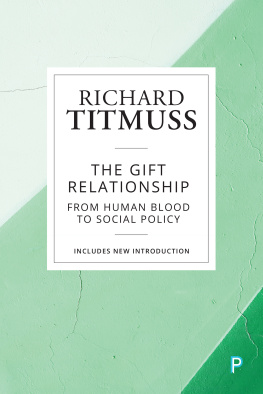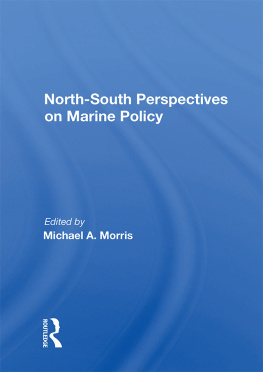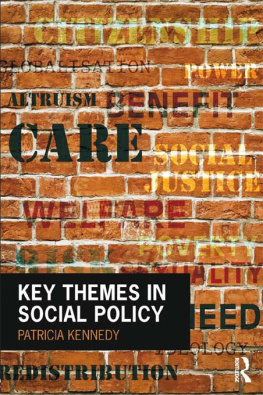First published in Great Britain in 1970 by George Allen and Unwin Ltd. Second edition published in 1997 by LSE Books.
This edition published in 2018 by
Policy Press University of Bristol 1-9 Old Park Hill Bristol BS2 8BB UK Tel +44 (0)117 954 5940 e-mail
North American office: Policy Press c/o The University of Chicago Press 1427 East 60th Street Chicago, IL 60637, USA t: +1 773 702 7700 f: +1 773-702-9756 e:
Literary Executors of Richard Titmuss 2018
British Library Cataloguing in Publication Data
A catalogue record for this book is available from the British Library.
Library of Congress Cataloging-in-Publication Data
A catalog record for this book has been requested.
ISBN 978-1-4473-4957-0 hardcover
ISBN 978-1-4473-4961-7 ePub
ISBN 978-1-4473-4962-4 Mobi
ISBN 978-1-4473-4959-4 ePdf
All rights reserved: no part of this publication may be reproduced, stored in a retrieval system, or transmitted in any form or by any means, electronic, mechanical, photocopying, recording, or otherwise without the prior permission of Policy Press.
The statements and opinions contained within this publication are solely those of the author and not of The University of Bristol or Policy Press. The University of Bristol and Policy Press disclaim responsibility for any injury to persons or property resulting from any material published in this publication.
Policy Press works to counter discrimination on grounds of gender, race, disability, age and sexuality.
Cover design by blu inc, Bristol
Front cover: image kindly supplied by istock
Readers Guide
This book has been optimised for PDA.
Tables may have been presented to accommodate this devices limitations.
Image presentation is limited by this devices limitations.
John Stewart
The Gift Relationship : Origins and Arguments
Richard Titmusss The Gift Relationship: From Human Blood to Social Policy appeared in the United Kingdom in 1970 and in the United States in 1971 and was his last major work published in his lifetime. It dealt with the acquisition of blood for transfusion in, especially, Britain and the US. To summarise its argument, discussed further below, Titmuss, utilising a large volume of empirical data, argued that the British system involved donors giving voluntarily and for no material reward and, given that they could not know the recipients of their donations, effectively to strangers. This took place within the necessary framework of a system of socialized health care (the National Health Service NHS). In America, by contrast, commercial considerations were often to the fore with, for example, those down on their luck selling blood to commercial blood banks. For Titmuss, the British system was more morally just, and more economically efficient, than its American counterpart. Altruism thus triumphed over the market.
The book had a long gestation, part of which involved an acrimonious dispute between Titmuss and the free-market think tank, the Institute of Economic Affairs (IEA).
A further challenge came with M.H. Cooper and A.J. Culyers The Price of Blood , published by the IEA in 1968. This identified a fundamental disagreement between libertarians and collectivists over health care provision. The former saw the price mechanism as the only system consistent with personal freedom and responsibility while the latter placed their faith in the ballot box and centralised decisions on matters affecting consumer welfare. Recent debates about the supply of blood illustrated such differences. Titmuss, obviously a collectivist, was criticised, for example, over his claim that blood supplies in Britain were adequate. It was not enough to demonstrate an increased supply of blood donated to the NHS without showing any increase in demand. Lacking such data, a large increase in supply could refer to situations ranging from dire shortage to superabundance. Nor had Titmuss satisfactorily shown that any shortfalls in supply in America could be attributed meaningfully to the estimated 20 per cent for which payment is made. Cooper and Culyer thus argued that blood was an economic commodity and hence amenable to economic analysis. Value judgements and ethical matters should be seen as separate from economic concerns. So, when the fog of polemics cleared, it was evident that payment for blood can be both sensible and humane.
By spring 1969 Titmuss had produced an advanced draft of The Gift Relationship no doubt with the IEA in mind, this was sent to a lawyer and by early 1970 it was virtually complete. What did the book say? Its starting point was human blood: the scientific, social, economic and ethical issues involved in its procurement, processing, distribution, use and benefit in Britain, the US, and various other countries (p 1 this volume). Consequently, much space was devoted to topics such as the demand for, and the supply of, blood in various countries. The characteristics of donors were also analysed. All this was backed up, typically of Titmuss, by a deluge of statistical data, displayed in the original edition in 18 Tables in the main body of the text and in a further 24 in the seven Appendices. Not for nothing had Titmusss early career been with an insurance company, where he had learned to handle large volumes of such material.
Titmusss empiricism sat alongside, and was complementary to, what is described on the dust jacket of the books first edition as his social philosophy. Titmuss utilised the research of other social scientists, notably the anthropologist Marcel Mausss The Gift . Remarking approvingly on this work, Titmuss argued that it showed how non-economic giving told much about the texture of personal and group relationships in different cultures, past and present. While modern societies had gained much from large-scale economic systems, this had been at the expense of exchanges based on a moral transaction which engendered personal relationships between individuals and groups (p 54 this volume). So morality was crucial, and Titmusss approach to social policy sought to give it a moral foundation and so promote the kind of relationships which had, at least to some degree, been lost. Specifically, social policy should enable altruism. For Titmuss, no money values can be attached to the presence or absence of the spirit of altruism in a society. While voluntary blood donation was indicative of the exercise of altruism, the latter may touch every aspect of life and affect the whole fabric of values. Humans had a biological need to help one another, and nowhere more so than in modern societies (p 167 this volume). In one of the books most striking passages, Titmuss suggested that individuals giving blood voluntarily were taking part in the creation of a greater good transcending the good of self-love. In order to love themselves donors had recognized the need to love strangers. All this was antithetical to the operations of the free market. Indeed, one of the functions of atomistic private market systems was to undermine the sense of social obligation individuals felt towards one another, regardless of the consequences (p 204 this volume). Even by this brief account we can see the moral basis of Titmusss social philosophy, its implications for social policy, and why he aroused the hostility of proponents of the free market like the IEA.










